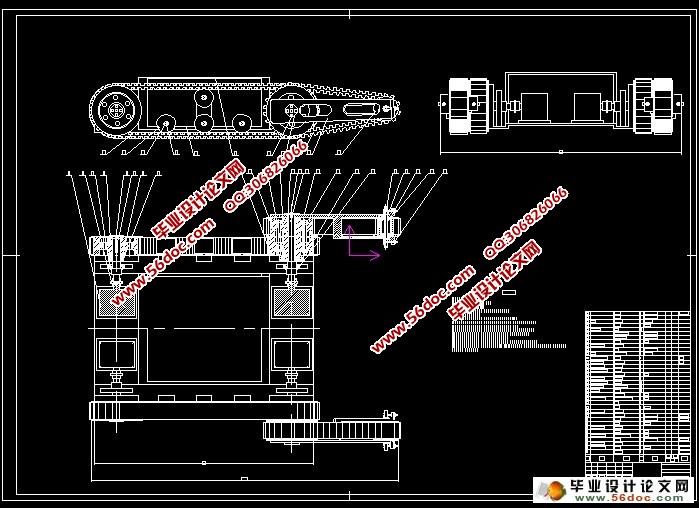四履带搜救机器人机械结构设计-摆臂设计
无需注册登录,支付后按照提示操作即可获取该资料.
四履带搜救机器人机械结构设计-摆臂设计(开题报告,中期检查表,外文翻译,论文说明书23000字,CAD图4张)
摘 要
本论文研究工作的目的是设计结构新颖、具有独创性的可携带、抗一定冲击的履带移动机器人,以能够适应在恶劣环境和复杂路况下工作。通过在移动系统上加载不同的探测传感设备,能够实现搜救机器人不同的使用功能,本研究意义在于为后续设计的搜救机器人提供一个基础的动力平台,以便于能够开发出更多使用功能的搜救机器人。
本研究所设计的搜救机器人移动方案是履带式驱动结构。该方案采用模块化设计,便于拆卸维修,可以适应不同情况的复杂路面,并可主动控制两侧肋板的转动来调节机器人姿态变化,辅助爬坡、越障和跨沟;机器人经过合理的结构布局和设计后具有良好的环境适应能力、机动能力。本论文所设计主的机器人移动机构主要由四部分组成:主动轮减速驱动机构、肋板转动机构、摆臂减速器机构、履带及履带轮运动机构。
关键字:搜救机器人;摆臂,履带式 减速器
Abstract
The purpose of this thesis is to design novel structure, its unique portable,shoc-k intelligently tracked mobile robot, in order to be able to adapt to the harsh environment and the complicated road to work.Mobile systems loaded by different mo-ules, search and rescue robots can be achieved using different functions, this studyis important because other people's search and rescue robot designed to provide a basis for the dynamic platform to facilitate greater use of features can developsear-ch and rescue robots. This resoarch is moving search and rescue robot crawler.The program is modular in design, easy disassembly maintenance, can be complex adaptive sub-surface, active control can turn on both sides of flange module to adjust the robot pose changes, supporting climbing,obstacle and cross-channel.The design of the robot moving mechanism mainly consists of four components. Active wheel reducer drive mechanism, flange rotation institutions, adaptive road implementing agencies, sports organizations track and track wheels.
Key words: search and rescue robots; swing arm;crawler;
Retarder;




目录
前 言................................................3
1 绪 论..............................................7
1.1课题研究背景及意义...............................7
1.1.1 课题研究背景..............................7
1.1.2 课题研究意义..............................8
1.2国内外的研究概况.................................9
1.2.1 国外研究现状..............................9
1.2.2 国内研究现状.............................14
1.2.3 搜救机器人的技术发展方向.................17
2 搜救机器人的移动机构分析...........................21
2.1井下复杂环境对搜救机器人的要求..................21
2.2移动机构方案论证分析............................22
2.2.1 轮式移动机构特点.........................22
2.2.2 腿式移动机构特点.........................23
2.2.3 履带式移动机构特点.......................24
2.2.4 履、腿式移动机构特点.....................25
2.2.5 轮、履、腿式移动机构性能比较.............26
2.3 本研究采用的行走机构...........................26
2.4 救灾机器人性能指标与设计.......................27
2.5 本章小结.......................................28
3 搜救机器人运动参数设分析计算.......................29
3.1 机器人越障分析.................................29
3.1.1 机器人跨越台阶...........................30
3.1.2 机器人刮越沟壑...........................32
3.2 斜坡运动分析...................................33
3.3 本章小结.......................................34
4 摆臂减速去设计.....................................35
4.1 摆臂电机选择...................................35
4.2 摆臂减速器设计.................................35
4.2.1 减速器方案对比分析...................... 35
4.2.2 减速器应满足要求.........................37
4.3 摆臂减速器设计计算.............................37
4.3.1 摆臂减速器的参数计算.....................37
4.3.2 摆臂减速器的齿轮计算.....................39
4.3.3 轴的设计.................................43
4.4 本章小结.......................................47
5 履带的设计计算.....................................49
5.1 带的选择.......................................49
5.2 计算带的型号和节距.............................50
5.3 计算主从动轮直径...............................51
5.4 本章小结.......................................52
6 摆臂结构设计.......................................53
6.1 摆臂作用.......................................54
6.2 肋板部分设计...................................56
6.3 摆臂参数计算...................................58
7 总结与展望..........................................59
致谢................................................61
参考文献............................................62
